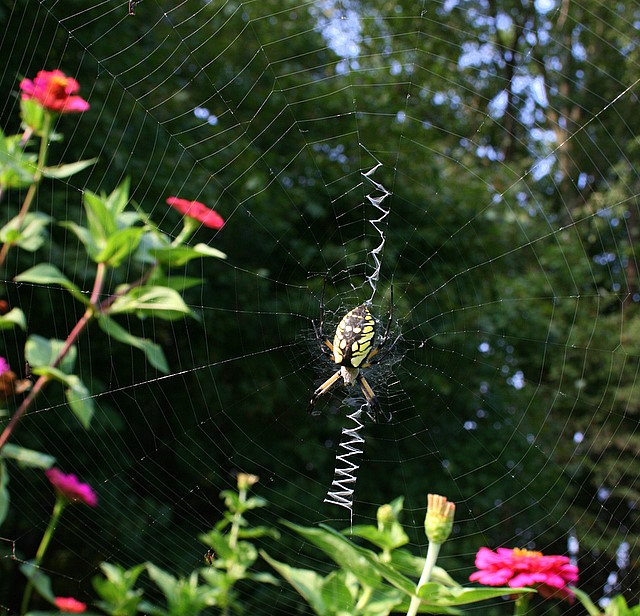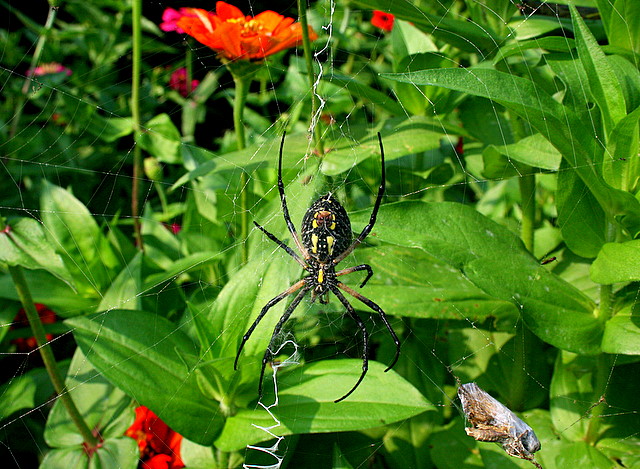| ||||||||||
Dr. Ronald P. Rogers CHIROPRACTOR Support for your body's natural healing capabilities 270-384-5554 Click here for details 


Columbia Gas Dept. GAS LEAK or GAS SMELL Contact Numbers 24 hrs/ 365 days 270-384-2006 or 9-1-1 Call before you dig Visit ColumbiaMagazine's Directory of Churches Addresses, times, phone numbers and more for churches in Adair County Find Great Stuff in ColumbiaMagazine's Classified Ads Antiques, Help Wanted, Autos, Real Estate, Legal Notices, More... 

|
A SPIDER STORY: Alice Doesn't Live Here Anymore The author wrote this wonderful story for her daughter's web site (www.theanticraft.com) last year. It's all about the Garden Spider. She is sharing it with ColumbiaMagazine.com readers, who have been showing a greater appreciation of these beautiful, beneficial, and fascinating creatures By Barbara Armitage Your mother will tell you that giving birth is the most rewarding thing a woman can do. I'd like to tell you that's crap. There are hundreds of reasons for giving birth--tequila, for example, is very popular The truth is that our species has been perpetuated for thousands of years solely for the purpose of fulfilling the parental curse: "I hope that you have one just like you!" There are befits to procreation other than parental revenge--like having someone you can embarrass in front of their friends, or someone you can make feel guilty because they didn't call you--but my personal favorite is the sheer joy of scaring the heck out of an innocent child. Before any child-rights, family-advocacy, tofu-eating pacifists get your knickers in a twist, stop. I have one word for you (or is it three?): Peek-a-boo! Yeah, you've done it, too. You have no moral high ground here. This is where my fascination with spiders began. You see, my daughter was scared poopless at first sight of the tiniest little arachnid. I just loved the high pitched squeal and the tippy toe dance that inevitably followed each encounter. Her cute little face would scrunch up and turn red, the explosion would begin to build until it burst forth: "MOM!!!!" I became addicted to the adrenaline rush I felt each time I lured her into my spider trap. Halloween became a sacred holiday, offering me endless opportunities to frighten her out of several months' worth of growth. Alice taught me to appreciate spiders for more than a running gag In the beginning any old rubber spider would do. Then I met Alice. Alice was a Garden Spider, an Argiope aurantia. She taught me to appreciate spiders for more than just a running gag. She came to live outside my bedroom window in 1999, and all summer she spun her web outside the panes. I watched her work, fascinated at her compete devotion to her task. Our one-sided friendship grew as I watched her every morning, sitting perfectly still in the center of her web, waiting patiently as if she had all the time in the world instead of just a few precious months. Like most spiders, Alice's life would end with the first frost of winter. One morning in late October Alice was gone. I found her beneath the window in the flower garden, hidden in the last of the impatiens, dying. That's when I found her eggs. Garden spiders create sacs that resemble tiny, old, brown paper bags to hold their eggs, with between 300 and 1400 eggs in each sac. Even though the eggs hatch in the Fall, the young spiders remain in the sac protected from predators throughout the winter. They only come out in the Spring, preprogrammed by Nature ready to spin their own web and start the life cycle again. Alice left behind two things that year: a thousand or so babies and the lesson she taught me. Life is short--live in the moment. My thanks to Alice, and all the Alices that have come after her, for reminding me each year that every moment of the day is to be enjoyed. My first Alice was a beautiful Garden Spider My first Alice was a beautiful Garden Spider. She was big with a black patent leather egg-shaped body nearly 1 inches long, splashed with brilliant yellow markings, and long black and yellow legs. Garden Spiders are orb weavers, creating complicated, large wagon-wheel shaped webs. A web will take hours to create and the constant repair or replacement of it is life or death for the spinner. Without a stout, well built web, she has no chance of catching and holding the food she needs. She begins her task by first dropping a line from a high place and letting it drift in the breeze until it attaches itself to a spot lower down. Like a sky scraper steel worker, she creates an architectural miracle of braces and supports that help her build the spokes of a wheel, her silken thread 5 times stronger than steel. With the foundation finished, she switches to spin a sticky thread to form the circles that spiral out from around from the center of the wheel. A finished web is a delicate maze known only to the spider: tread safely only on the spokes of the wheel; step on the circle and even the spider can become entangled. A spider's silk is amazingly durable and still lightweight. If spider silk could be produced in large quantities, it could replace steel in cars and aircraft, saving vast amounts of energy. Spiders are naturals at the ancient art of weaving. The word arachnid comes from the Greek arachne. Legend tells that there once was a woman named Arachne who was a very skilled weaver of cloth. She was so convinced of her skill that she even challenged the goddess Athena to a weaving contest. Now Athena was the goddess of wisdom and the arts, which included spinning and weaving. Athena could not ignore such a bold challenge and agreed to the contest. Both Arachne and Athena worked furiously to design and weave the loveliest cloth, but in the end Athena won. By some accounts, Athena then turned Arachne into a spider for her foolish arrogance, but others say Arachne grew depressed and hung herself, and that it was Athena's mercy that caused her to bring Arachne back to life, but as a spider. By either account, talented Arachne was doomed to practice her weaving only in her webs. Garden spiders are known as writing spiders Garden spiders are also known as "writing spiders" because of the zigzag pattern called stabilimenta (singular: stabilimentum) that they weave into the center of their beautiful webs. This pattern of Xs that extends in a vertical line through the middle of the web is the only part of a web that reflects UV light, making the remaining web appear almost invisible--thus that terrifying moment when you feel yourself walk into a web you did not see. There are a few theories on why stabilimenta are woven. The first, obviously, is for structural stability. Another is that it attract insects, and yet a third claims it's to warn off birds. But are Arachne's daughters perhaps speaking to us? Beloved Charlotte of Charlotte's Web spoke out and changed the future for Wilbur with one word: Folklore holds that if a woman carefully watches a writing spider in the early morning dew, the spider will write the name or the initials of the man she is to marry in her web. I watched this year's Alice spin her webs in the branches of the orange tree out back. Every morning all summer I looked for messages and although I found letters woven in the web I did not see a complete name. Is it a coincidence, though, that Alice's writings were filled with Ws and As, the initials of my husband? I like thinking that she knew that. I have come to depend on my "Alices" to be here every year. They've become my garden help mates. She and her sisters help control the insect population and don't damage the plants. What better organic pesticide could you ask for? To increase the chances that an Alice will take up residence in your garden, try building a Spider's Parlor for her to spin her web in. Don't forget to check the web for messages. This story was posted on 2008-08-18 19:04:31
Printable: this page is now automatically formatted for printing.
Have comments or corrections for this story? Use our contact form and let us know.
More articles from topic News:
Obituary: Lyrik Ja'Sa Amos, infant, dies Witchitaw Band will perform at free concert Labor Day Reminder: ACPL has two story hours each Wednesday ACHS Girls Golf finishes 10 places higher at Lady Bruin this year Save Pinewood Country Club meeting tomorrow night Alford-Upchurch wedding set for September 20, 2008 Columbian is wife of new Alderson-Broaddus College president KY Concealed Deadly Weapon Permit Classes start Sept. 6, 2008 (ADV): The weather is right! Send yard sales now John and Myrtle Bailey Reunion is Sat., Aug. 30, 2008 View even more articles in topic News |


|
||||||||
|
| ||||||||||
|
Quick Links to Popular Features
Looking for a story or picture? Try our Photo Archive or our Stories Archive for all the information that's appeared on ColumbiaMagazine.com. | ||||||||||
|
Contact us: Columbia Magazine and columbiamagazine.com are published by Linda Waggener and Pen Waggener, PO Box 906, Columbia, KY 42728. Please use our contact page, or send questions about technical issues with this site to webmaster@columbiamagazine.com. All logos and trademarks used on this site are property of their respective owners. All comments remain the property and responsibility of their posters, all articles and photos remain the property of their creators, and all the rest is copyright 1995-Present by Columbia Magazine. Privacy policy: use of this site requires no sharing of information. Voluntarily shared information may be published and made available to the public on this site and/or stored electronically. Anonymous submissions will be subject to additional verification. Cookies are not required to use our site. However, if you have cookies enabled in your web browser, some of our advertisers may use cookies for interest-based advertising across multiple domains. For more information about third-party advertising, visit the NAI web privacy site.
| ||||||||||






















































